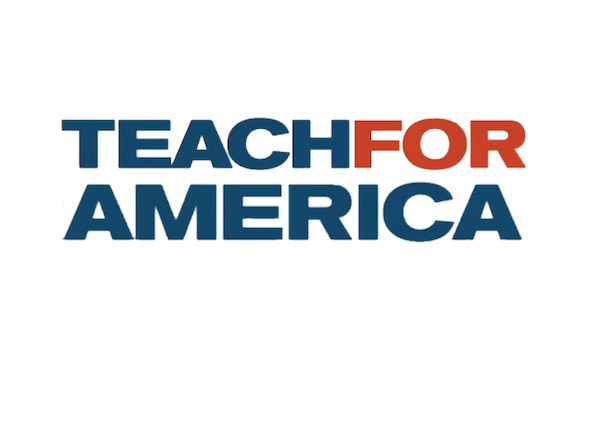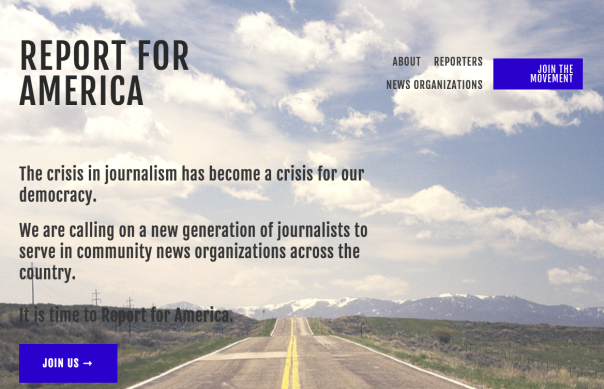A new journalism fellowship program mirrors the well-known national teacher recruitment organization — while hoping to avoid some of its missteps.
By Alexander Russo
Twenty years ago, a young would-be journalist could probably get a job at a small or medium-sized news outlet and learn the ropes. That person might stay put a while or move somewhere else. The jobs weren’t usually filled with glory. But they were plentiful. Local newspapers were doing OK.
These days, it would be much harder for that person to get a job and stay hired. Job openings are scarce and the layoffs keep coming. By some estimates, the number of jobs in journalism in the United States has dropped by almost half since 1990.
An ambitious new initiative aims to make a dent in improving that scenario — and the much-discussed hollowing out of local news coverage — modeled in part on the well-known Teach For America (TFA) model.
Beginning next month, Report For America (RFA) will start placing reporters in local newsrooms for a year or two.
The new effort says it’s “calling on a new generation of journalists to serve in news organizations nationwide.” But the goal here is not simply to provide initial training and short-term relief but also to help local news outlets to regain some of the coverage that they may have lost.
They’ll start with 12 reporters the first year, ramping up quickly to a goal of 1,000 reporters five years from now.
It sounds promising and noble, and it’s generated a lot of admiring buzz. Who doesn’t want to hear about something shiny, new, and uplifting in journalism right now?
But there are several questions about the new effort, especially for education insiders and writers: Just how similar is it to TFA, anyway? How will it avoid some of the flaws and controversies that have confronted the education nonprofit over the years? Is it likely to make a difference, in any large-scale way, given the enormity of the challenges journalism faces?
“On the plus side, this effort targets news outlets in communities where you can hear the death rattle for local news,” notes longtime education writer Beth Hawkins, currently writing at The 74. “On the downside… we lose institutional memory when seasoned reporters have to leave for communications or advocacy to feed their families.”

ProFellow lists 40 journalism fellowships. Poynter lists 85.
Internships and fellowships have long been a way for new reporters to get a start, and they still are out there. Poynter’s latest roundup of offerings lists nearly a hundred. There’s also been a steep increase in education journalism fellowships in recent years.
Targeted fellowships – in particular those focused on investigative journalism and creating a more diverse pipeline of reporters – are all the rage lately. A new program gets announced seemingly every day.
Some fellowships give reporters extra time and money to do projects they normally would not be able to undertake. Others provide short-term jobs in existing newsrooms that would presumably otherwise not be available. A precious handful provide year-long sabbaticals at university schools of journalism.
The RFA model is focused on supporting relatively large numbers of journalists who will perform a wide range of basic reporting tasks, according to co-founder Steven Waldman, rather than more sophisticated (and expensive) investigative work that some other fellowships emphasize, often with many fewer participants.
Under the RFA model, the organization pays half of a reporter’s $40,000 salary and benefits, the partner newsroom pays a quarter, and a local sponsor or foundation pays the last portion. There’s an option for a second year, if all sides are interested. But it’s not required.
The RFA model is focused on supporting relatively large numbers of journalists who will perform a wide range of basic reporting tasks, according to Waldman, rather than more sophisticated (and expensive) investigative work that some other fellowships emphasize.
The first phase of RFA launches in January, with three reporters working for West Virginia Public Broadcasting, the Lexington Herald-Leader, and the Charleston Gazette-Mail.
The second phase will begin in June, says Waldman, with an additional nine reporters in nine more newsrooms. The tentative plan is to open up the process to interested reporters in mid-January.
There were 250 applications for the initial three reporter openings, according to Waldman. By the time of the December 1 deadline, they had received 85 newsroom applications for the nine initial newsroom spots.
“I was really staggered by the quality of the reporters and newsrooms that applied,” says Waldman. “Clearly this has hit a nerve.”
It’s a timely and ambitious effort. The people behind it are experienced hands. The Ford Foundation sponsored the 2015 study that led to the creation of RFA. And the lead funders include heavy hitters like Google (through its News Lab), the Lenfest Institute for Journalism, the Knight Foundation, and the Galloway Family Foundation.
But will it work?

The connections between TFA and journalism are well known. Journalist Walter Isaacson was a longtime TFA board member. James Foley, the journalist who was captured and killed in the Middle East three years ago, is perhaps the best known alumni reporter. Just off the top of my head I can think of numerous alumni who cover education.
And so there are a number of strong similarities between the new program and Teach For America, several of them (like the name) quite intentional:
- The model appeals to lofty ideas like public service and the support of democracy.
- The reporters are called “corps members.”
- The program is providing an alternative pathway into the profession that may or may not result in being placed in a traditional newsroom.
- It’s a relatively short-term commitment.
Waldman and cofounder Charles Senott outlined the idea in a Columbia Journalism Review piece last September, highlighting journalism’s need to be more trustworthy and less interested in generating pageviews and social media shares.
Though TFA isn’t the only inspiration behind the name — there’s also Code for America and Venture for America – the parallels are no accident. Waldman says he’s gotten feedback and advice from current TFA members about the model. TFA founder Wendy Kopp is on the advisory board.
“Using that construction is a way to quickly signal to people what this is,” says Waldman about how the program got its name, “People get it right away — a national service program for journalists.”
And, while those of us inside the education bubble might be surprised at RFA’s decision to attach itself to a TFA brand that has gone through several waves of controversy, the comparison is one that Waldman welcomes.
TFA “has become synonymous with a certain kind of service program,” says Waldman, evoking talented people rolling up their sleeves to do important work. Over the years, says Waldman, TFA has “both done so much well, and when they have run into a problem they’ve researched it and considered it and evolved.”

There are several key differences, too:
While TFA was a response to a perceived lack of highly qualified college graduates who wanted to go into teaching in some of the most challenging schools in the nation, the motivation behind RFA is the implosion of the economic model behind local journalism.
While the TFA model asks funders to support a nonprofit organization (TFA) and a school district, RFA is asking local foundations to fund an effort that may be housed in a for-profit company – and asking newsrooms to take funding from outside foundations and other sponsors
RFA also hopes to avoid some of the concerns and challenges that have dogged TFA at various times and places:
TFA was for several years criticized for recruiting too few minority teachers to its programs, which led it to revamp its efforts in recent years. RFA hopes to attract a diverse corps of participants from the start, pushing newsrooms toward diversity they have long lacked. “That’s one of the things I think news organizations are looking to us for,” says Waldman.
In some places, TFA corps members were perceived to be outsiders parachuting into schools and taking a “savior” attitude toward the communities to which they’d been assigned. “Our view is that there are advantages to having people from the community and from outside,” says Waldman. “Some sort of mix is probably the best approach.” RFA is experimenting with the idea of having its reporters include a mix of people from within and outside the local region.
Though the organization now says that it only places teachers in districts that are hiring from multiple sources, TFA has in the past been accused of displacing veteran teachers in school systems where enrollment was dropping and jobs were scarce. There’s less concern about replacing veteran journalists, according to Waldman, simply because the numbers of reporters working has been falling so rapidly. “The unmet need is massive, so there’s plenty of room to add more reporters.”
But the concern has been raised on social media. “How do you create these sorts of programs while helping to shore up the people and skills that already exist?” asks Poynter’s Kristen Hare, who among other things puts out a great newsletter on local news innovation. “They have to be adding. They can’t be replacing people that deserve to be there.”
Waldman says that they’re working on final language that will include specific prohibitions on news organizations using RFA members to enable layoffs.
RFA is also developing language that would attempt to keep funders from having any influence on news coverage – a concern that’s plagued some past foundation-funded efforts to support journalism in education and other areas.
“You need to have some firewalls up,” says Hare. And you need to be smart about who funds what, she says. “It would be really stupid to let the local hospital fund your health reporter.”
“Report for America won’t save journalism, just as Teach For America can’t save teaching, and the Peace Corps hasn’t brought about an era of global unity. But in a time of crisis for local newsrooms, it’s a bold attempt to reinvigorate a vital organ of American society.” – CJR reporter (and TFA alumnus) Pete Vernon
By and large, the reaction to the launch of RFA has been positive. The initiative rollout has been eagerly covered.
The main question seems to be whether RFA will be big and successful enough to make a difference.
“Report for America won’t save journalism, just as Teach For America can’t save teaching, and the Peace Corps hasn’t brought about an era of global unity,” wrote CJR’s Pete Vernon a few months ago. “But in a time of crisis for local newsrooms, it’s a bold attempt to reinvigorate a vital organ of American society.”
RFA’s founders aim is to get much further than that. The RFA goal is to “expand the capacity of local journalism on a permanent basis,” says Waldman, in large part by engaging local foundations to support public service journalism in ways that they haven’t had to until now.
Making sure the RFA reporters stick around is key, according to Hare. “It takes time to build sources and become a great beat reporter,” says Hare. “I think it takes more than year.”
But even if the pairing doesn’t work or the job dries up after a year or two, Waldman hopes that RFA alumni will become advocates for high-quality local journalism.
“There are two ways that a RFA person can have a positive impact,” he says. One is the work they do. But if they go off to do something else, “we think they will be ambassadors to the rest of the nation about the journalistic process, the importance of journalism, the importance of truth.”
Sound familiar?
ABOUT THE AUTHOR

Alexander Russo
Alexander Russo is founder and editor of The Grade, an award-winning effort to help improve media coverage of education issues. He’s also a Spencer Education Journalism Fellowship winner and a book author. You can reach him at @alexanderrusso.
Visit their website at: https://the-grade.org/













